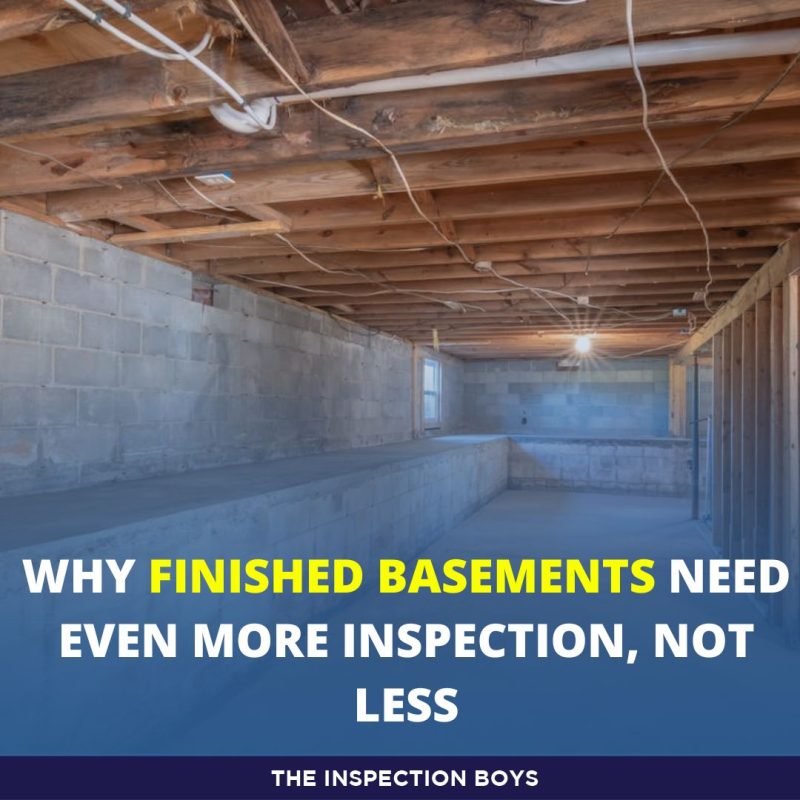It’s easy to assume that a finished basement is a good sign. After all, someone spent time and money turning a below-grade space into something livable. Maybe there’s a guest bedroom, a media room, even a bar or a bathroom. It looks clean, dry, and polished. But when it comes to home inspections, finished basements are often the ones that need the closest look, and not because they’re messy. It’s because they’re hiding things.
Covering Up Problems, Sometimes Literally
A finished basement is full of layers: drywall, paneling, flooring, ceiling tiles. While those layers might make the space look better, they also cover up key areas an inspector would normally evaluate. In an unfinished basement, you can see the foundation walls, the floor slab, exposed plumbing, electrical runs, insulation, and even the structure above. In a finished basement, most of that is hidden. That doesn’t mean it’s not inspected, but it does mean the inspection is limited.
That limitation is a problem when you’re trying to understand a home’s true condition. A finished basement might have had water issues in the past. It might have cracks in the foundation or signs of settling. It might have mold behind the walls, improperly vented appliances, or DIY electrical work. But if it’s all tucked behind drywall and carpet, it takes a trained eye and often some clues from elsewhere to catch those signs.
Moisture Issues Can Be Masked, Not Solved
Basements are naturally prone to moisture. They sit below grade, close to the water table, and are surrounded by soil that expands and contracts with the seasons. That’s why moisture management is one of the biggest focuses during any basement inspection.
In unfinished basements, signs of moisture are easier to spot: staining on concrete walls, efflorescence, puddles near the perimeter, or musty smells. In finished basements, these signs can be hidden or actively covered up. Fresh paint, new carpet, or a strategically placed dehumidifier might reduce visible or olfactory evidence, but they don’t fix the root problem.
An experienced inspector will still pick up on moisture issues by using thermal imaging, moisture meters, or careful observation. They’ll also check exterior grading, downspout placement, and the presence of sump pumps or drainage systems. But there’s no denying that finished surfaces make the job harder, and sometimes, moisture problems only become obvious after the damage has gotten worse.
Permits and Workmanship Matter More Than Ever
Finished basements often involve electrical wiring, plumbing, framing, insulation, and HVAC extensions. In most areas, that work is supposed to be permitted and inspected during construction. Unfortunately, many homeowners finish basements themselves or hire contractors who skip that step to save money.
A home inspector isn’t a code enforcement officer, but they can recognize signs of unpermitted or poorly executed work. Maybe outlets aren’t grounded, joists have been notched improperly, or plumbing was added without proper venting. These are more than technical violations. They can create real safety hazards. Worse, you might not know what you’re getting until after you move in and something fails.
That’s why inspectors often recommend checking with the local building department for permit history, especially if the basement looks recently remodeled. If there’s no record of permits, that doesn’t mean the work is bad, but it does raise questions worth exploring.
Finished Spaces Can Miss Basic Safety Requirements
Some of the most common issues found in finished basements relate to safety features that were ignored or worked around. Egress windows are a prime example. If the basement includes a bedroom, it legally needs an egress window large enough for someone to escape in an emergency and for a firefighter to enter.
Similarly, finished basements sometimes reroute HVAC systems in ways that reduce airflow, or they cover up shutoff valves and access panels. Smoke detectors, carbon monoxide detectors, and GFCI outlets are all required in certain locations, but they’re easy to overlook during an informal remodel.
An inspector’s role is to identify these risks and call them out, not to scare anyone, but to help buyers understand what’s missing or needs correction. Finished doesn’t always mean functional, and it definitely doesn’t always mean safe.
Hidden Structural Clues Can Get Missed
One of the most valuable aspects of a basement inspection is the ability to evaluate the structure. That includes foundation walls, support beams, sill plates, floor joists, and columns. These components tell a story about the home’s stability, age, and how well it’s been maintained over the years.
In a finished basement, those clues are often concealed. Drywall hides foundation cracks. Suspended ceilings block views of old wiring or sagging joists. Carpet covers stains from water intrusion or even settlement. That’s not to say the problems don’t exist. They’re just harder to see.
A good inspector will look for indirect signs. Is there uneven flooring above? Are there minor wall cracks upstairs that align with the basement level? Is the floor in the basement out of level? Even small things can point to larger issues.
So, What Should Buyers Do?
If you’re buying a home with a finished basement, don’t assume it’s problem-free just because it looks nice. Ask questions. Who finished the basement? Was it permitted? Are there warranties or documentation for the work? And make sure your home inspection includes a careful evaluation of what can be seen.
Understand that in some cases, limitations will apply. Inspectors don’t cut into drywall or pull up flooring, but they will note signs of concern and may recommend further evaluation. If there are red flags, especially around moisture or structural integrity, it may be worth bringing in a specialist.
Ultimately, a finished basement can be a wonderful feature. But only if it’s done right, maintained well, and doesn’t hide bigger problems behind its pretty walls. That’s why it deserves more scrutiny, not less.

